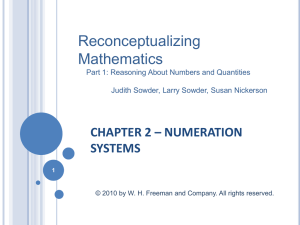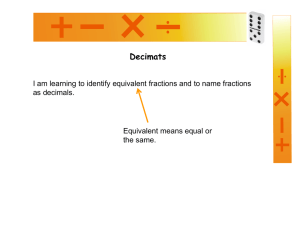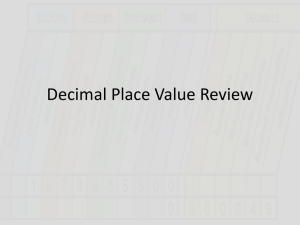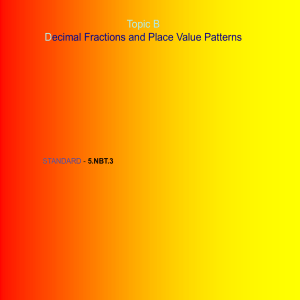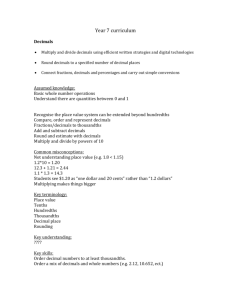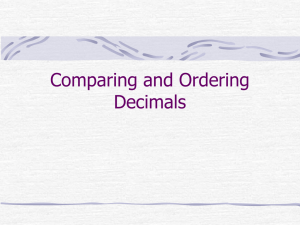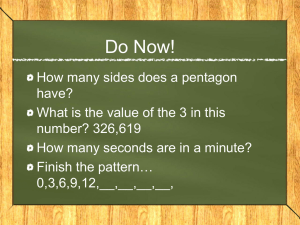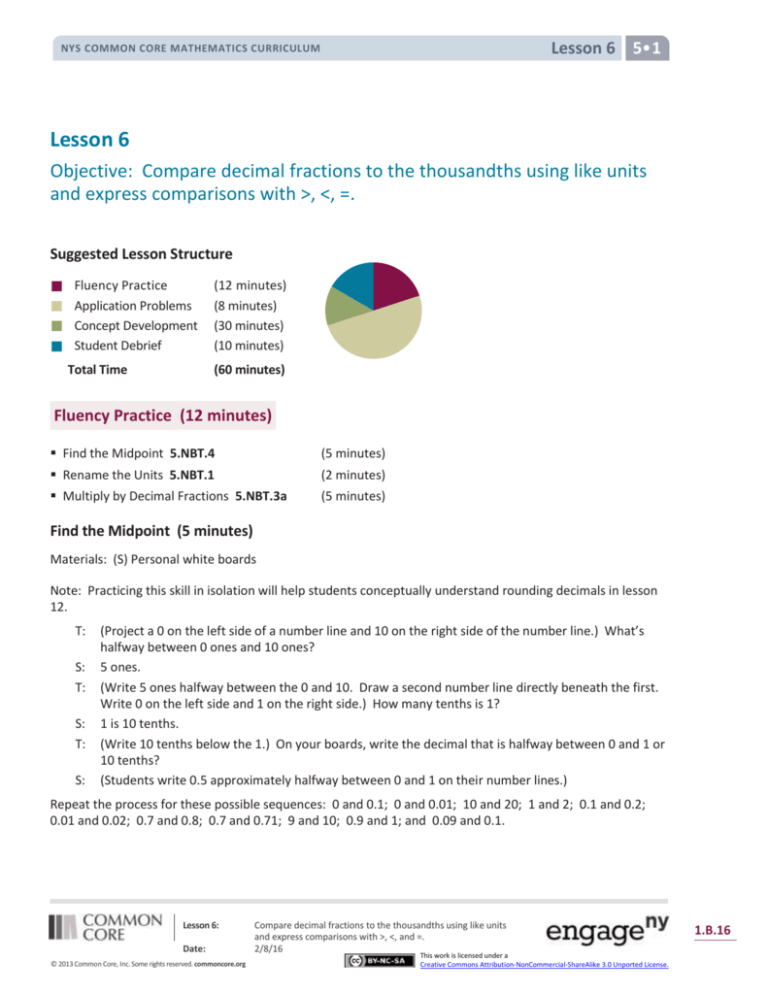
Lesson 6 5•1
NYS COMMON CORE MATHEMATICS CURRICULUM
Lesson 6
Objective: Compare decimal fractions to the thousandths using like units
and express comparisons with >, <, =.
Suggested Lesson Structure
Fluency Practice
Application Problems
Concept Development
Student Debrief
Total Time
(12 minutes)
(8 minutes)
(30 minutes)
(10 minutes)
(60 minutes)
Fluency Practice (12 minutes)
Find the Midpoint 5.NBT.4
(5 minutes)
Rename the Units 5.NBT.1
(2 minutes)
Multiply by Decimal Fractions 5.NBT.3a
(5 minutes)
Find the Midpoint (5 minutes)
Materials: (S) Personal white boards
Note: Practicing this skill in isolation will help students conceptually understand rounding decimals in lesson
12.
T:
S:
T:
S:
T:
S:
(Project a 0 on the left side of a number line and 10 on the right side of the number line.) What’s
halfway between 0 ones and 10 ones?
5 ones.
(Write 5 ones halfway between the 0 and 10. Draw a second number line directly beneath the first.
Write 0 on the left side and 1 on the right side.) How many tenths is 1?
1 is 10 tenths.
(Write 10 tenths below the 1.) On your boards, write the decimal that is halfway between 0 and 1 or
10 tenths?
(Students write 0.5 approximately halfway between 0 and 1 on their number lines.)
Repeat the process for these possible sequences: 0 and 0.1; 0 and 0.01; 10 and 20; 1 and 2; 0.1 and 0.2;
0.01 and 0.02; 0.7 and 0.8; 0.7 and 0.71; 9 and 10; 0.9 and 1; and 0.09 and 0.1.
Lesson 6:
Date:
© 2013 Common Core, Inc. Some rights reserved. commoncore.org
Compare decimal fractions to the thousandths using like units
and express comparisons with >, <, and =.
2/8/16
This work is licensed under a
Creative Commons Attribution-NonCommercial-ShareAlike 3.0 Unported License.
1.B.16
Lesson 6 5•1
NYS COMMON CORE MATHEMATICS CURRICULUM
Rename the Units (2 minutes)
Note: Reviewing unit conversions will help students work towards mastery of decomposing common units
into compound units.
T:
S:
T:
S:
T:
S:
T:
S:
(Write 100 cm = ____ m.) Rename the units.
100 cm = 1 meter.
(Write 200 cm = ____ m.) Rename the units.
200 centimeters = 2 meters.
700 centimeters.
7 meters.
(Write 750 cm = ____ m ____ cm.) Rename the units.
7 meters 50 centimeters.
Repeat the process for 450 cm, 630 cm, and 925 cm.
Multiply by Decimal Fractions (5 minutes)
Materials: (S) Personal white boards, place value charts to the thousandths
Notes: Review will help students work towards mastery of this skill, which was introduced in previous
lessons.
T:
S:
T:
S:
T:
(Project a place value chart from tens to thousandths. Beneath the chart, write 3 x 10 =____ .) Say
the multiplication sentence.
3 x 10 = 30.
(Write 3 in the tens column. Below the multiplication sentence write 30. To the right of 3 x 10, write
4 x 1 =____ .) Say the multiplication sentence.
4 x 1 = 4.
(Write 4 in the ones column and fill in the addition sentence so that it reads 30 + 4.)
Repeat process with each of the equations below so that in the end, the number 34.652 will be written in the
place value chart and 30 + 4 + 0.6 + 0.05 + 0.002 is written underneath it:
6x
T:
S:
T:
1
10
5x
1
100
2x
1
1000
Say the addition sentence.
30 + 4 + 0.6 + 0.05 + 0.002 = 34.652.
(Write 75.614 on the place value chart.) Write the number in expanded form.
Repeat for these possible sequences: 75.604; 20.197; and 40.803.
Lesson 6:
Date:
© 2013 Common Core, Inc. Some rights reserved. commoncore.org
Compare decimal fractions to the thousandths using like units
and express comparisons with >, <, and =.
2/8/16
This work is licensed under a
Creative Commons Attribution-NonCommercial-ShareAlike 3.0 Unported License.
1.B.17
Lesson 6 5•1
NYS COMMON CORE MATHEMATICS CURRICULUM
Application Problems (8 minutes)
Ms. Meyer measured the edge of her dining table to the thousandths of a meter. The edge of the table
measured 32.15 meters. Write her measurement in word form, unit form, and in expanded form using
fractions and decimals.
(Encourage students to name the decimal by decomposing it into various units, e.g., 3,215 hundredths; 321
tenths 5 hundredths; 32 ones 15 hundredths.)
Concept Development (30 minutes)
Materials: (S) Place value chart and marker
Problem 1
Compare 13,196 and 13,296.
MP.2
T:
S:
T:
S:
T:
S:
(Point to 13,196.) Read the number.
(Students read number.)
(Point to 13,296.) Read the number.
(Students read number.)
Which number is larger? How can you tell?
13,296 is larger than 13,196 because the digit in the hundreds place is one bigger. 13,296 is 100
more than 13,196. 13,196 has 131 hundreds and 13,296 has 132 hundreds, so 13,296 is greater.
T: Use a symbol to show which number is greater.
S: 13,196 < 13,296
Problem 2
Compare 0.012 and 0.002.
T:
S:
T:
S:
T:
S:
T:
S:
T:
S:
Write 2 thousandths in standard form on your place value chart. (Write 2 thousandths on the
board.)
(Students write.)
Say the digits that you wrote on your chart.
Zero point zero zero two.
Write 12 thousandths in standard form underneath 0.002 on your chart. (Write 12 thousandths on
the board.)
(Students write.)
Say the digits that you wrote on your chart.
Zero point zero one two.
Say this number in unit form.
1 hundredth 2 thousandths.
Lesson 6:
Date:
© 2013 Common Core, Inc. Some rights reserved. commoncore.org
Compare decimal fractions to the thousandths using like units
and express comparisons with >, <, and =.
2/8/16
This work is licensed under a
Creative Commons Attribution-NonCommercial-ShareAlike 3.0 Unported License.
1.B.18
Lesson 6 5•1
NYS COMMON CORE MATHEMATICS CURRICULUM
T:
S:
Which number is larger? Turn and talk to your partner about how you can decide.
0.012 is bigger than 0.002. In 0.012, there is a one in the hundredths place, but 0.002 has a zero
in the hundredths so that means 0.012 is bigger than 0.002. 12 of something is greater than 2 of
the same thing. Just like 12 apples are more than 2 apples.
Next, you might have the students write the two numbers on the place value chart and move from largest
units to smallest. Close by writing 0.002 < 0.012.
Problem 3
Compare
T:
S:
T:
S:
T:
S:
T:
S:
T:
MP.4
S:
T:
S:
299
1000
3
NOTES ON
MULTIPLE MEANS
OF ENGAGEMENT:
and 10
Write 3 tenths in standard form on your place value
chart.
(Students write.)
Write 299 thousandths in standard form on your place
value chart under 3 tenths.
(Students write.)
Which decimal has more tenths?
0.3
If we traded 3 tenths for thousandths, how many
thousandths would we need? Turn and talk to your
partner.
300 thousandths.
Name these decimals using unit form and compare.
Tell your partner which is more.
299 thousandths; 300 thousandths is more.
Show this relationship with a symbol.
0.299 < 0.3
Repeat the sequence with
705
7
and 10
1000
Help students deepen their
understanding of comparing decimals
by returning to concrete materials.
Some students may not see that 0.4 >
0.399 because they are focusing on the
number of digits to the right of the
decimal rather than their value.
Comparison of like units becomes a
concrete experience when students'
attention is directed to comparisons of
largest to smallest place value on the
chart and when they are encouraged
to make trades to the smaller unit
using disks.
.
and 15.203 and 15.21.
NOTES ON
MULTIPLE MEANS
OF ENGAGEMENT:
Encourage students to name the fractions and decimals using
like units as above, e.g., 15 ones 20 tenths 3 hundredths and 15
ones 21 tenths 0 hundredths or 15,203 thousandths and 15,210
thousandths. Be sure to have students express the
relationships using <, >, and =.
Provide an extension by including
fractions along with decimals to be
ordered.
Problem 4
Order from least to greatest: 29.5,
5
27.019, and 27
.
1000
Order from least to greatest: 0.413, 0.056, 0.164, and 0.531.
Have students order the decimals then explain their
strategies (unit form, using place value chart to compare
largest to smallest unit looking for differences in value).
Lesson 6:
Date:
© 2013 Common Core, Inc. Some rights reserved. commoncore.org
Compare decimal fractions to the thousandths using like units
and express comparisons with >, <, and =.
2/8/16
This work is licensed under a
Creative Commons Attribution-NonCommercial-ShareAlike 3.0 Unported License.
1.B.19
Lesson 6 5•1
NYS COMMON CORE MATHEMATICS CURRICULUM
Repeat with the following in ascending and descending
order: 27.005; 29.04; 27.019; 29.5; 119.177; 119.173;
119.078; and 119.18.
Problem Set (10 minutes)
Students should do their personal best to complete the
problem set within the allotted 10 minutes. For some
classes, it may be appropriate to modify the assignment
by specifying which problems they work on first. Some
problems do not specify a method for solving. Students
solve these problems using the RDW approach used for
Application Problems.
On this problem set, we suggest all students begin with
Problems 1, 2, and 5 and possibly leave Problems 3 and 6
to the end if they still have time.
Student Debrief (10 minutes)
Lesson Objective: Compare decimal fractions to the
thousandths using like units and express comparisons with
>, <, =.
The Student Debrief is intended to invite reflection and
active processing of the total lesson experience.
Invite students to review their solutions for the problem
set. They should check work by comparing answers with a
partner before going over answers as a class. Look for
misconceptions or misunderstandings that can be
addressed in the Debrief. Guide students in a conversation
to debrief the problem set and process the lesson. You
may choose to use any combination of the questions
below to lead the discussion.
How is comparing whole numbers like comparing
decimal fractions? How is it different?
You learned two strategies to help you
compare numbers (finding a common unit and
looking at the place value chart). Which
strategy do you like best? Explain.
Allow sufficient time for in depth discussion of
Problem 5. As these are commonly held
misconceptions when comparing decimals, it is
Lesson 6:
Date:
© 2013 Common Core, Inc. Some rights reserved. commoncore.org
Compare decimal fractions to the thousandths using like units
and express comparisons with >, <, and =.
2/8/16
This work is licensed under a
Creative Commons Attribution-NonCommercial-ShareAlike 3.0 Unported License.
1.B.20
Lesson 6 5•1
NYS COMMON CORE MATHEMATICS CURRICULUM
worthy of special attention. Ask: What is the
mistake that Lance is making? (He’s not using
like units to compare the numbers. He’s
forgetting that decimals are named by their
smallest units.) How could Angel have named
his quantity of water so that the units were the
same as Lance’s? How would using the same
units have helped Lance to make a correct
comparison? How is renaming these decimals
in the same unit like changing fractions to like
denominators?
Compare 7 tens and 7 tenths. How are they
alike? How are they different? (Encourage
students to notice that both quantities are 7,
but units have different values.) Also,
encourage students to notice that they are
placed symmetrically in relation to the ones
place on place value chart. Tens are 10 times
as large as ones while tenths are 1/10 as much.
You can repeat with other values, (e.g., 2000,
0.002) or ask students to generate values
which are symmetrically placed on the chart.
Exit Ticket (3 minutes)
After the Student Debrief, instruct students to complete the Exit Ticket. A review of their work will help you
assess the students’ understanding of the concepts that were presented in the lesson today and plan more
effectively for future lessons. You may read the questions aloud to the students.
Lesson 6:
Date:
© 2013 Common Core, Inc. Some rights reserved. commoncore.org
Compare decimal fractions to the thousandths using like units
and express comparisons with >, <, and =.
2/8/16
This work is licensed under a
Creative Commons Attribution-NonCommercial-ShareAlike 3.0 Unported License.
1.B.21
Lesson 6 Problem Set 5•1
NYS COMMON CORE MATHEMATICS CURRICULUM
Name
Date
1. Show the numbers on the place value chart using digits. Use >, <, or = to compare. Explain your thinking
to the right.
34.223
34.232
0.8
0.706
2. Use >, <, or = to compare the following. Use a place value chart to help if necessary.
a. 16.3
16.4
b. 0.83
83
100
c.
205
1000
0.205
d. 95.580
95.58
e. 9.1
9.099
f.
83 tenths
8.3
g. 5.8
Fifty-eight hundredths
Lesson 6:
Date:
© 2013 Common Core, Inc. Some rights reserved. commoncore.org
Compare decimal fractions to the thousandths using like units
and express comparisons with >, <, and =.
2/8/16
This work is licensed under a
Creative Commons Attribution-NonCommercial-ShareAlike 3.0 Unported License.
1.B.22
Lesson 6 Problem Set 5•1
NYS COMMON CORE MATHEMATICS CURRICULUM
h. Thirty-six and nine thousandths
4 tens
i.
202 hundredths
2 hundreds and 2 thousandths
j.
One hundred fifty-eight
thousandths
158,000
k. 4.15
415 tenths
3. Arrange the numbers in increasing order.
a. 3.049 3.059
3.05 3.04
_______________________________________________
b. 182.205 182.05 182.105
182.025
______________________________________________
4. Arrange the numbers in decreasing order.
a. 7.608
7.68
7.6
7.068
_______________________________________________
b. 439.216 439.126
439.612
439.261
_______________________________________________
Lesson 6:
Date:
© 2013 Common Core, Inc. Some rights reserved. commoncore.org
Compare decimal fractions to the thousandths using like units
and express comparisons with >, <, and =.
2/8/16
This work is licensed under a
Creative Commons Attribution-NonCommercial-ShareAlike 3.0 Unported License.
1.B.23
NYS COMMON CORE MATHEMATICS CURRICULUM
Lesson 6 Problem Set 5•1
5. Lance measured 0.485 liter of water. Angel measured 0.5 liter of water. Lance said, “My beaker has
more water than yours because my number has 3 decimal places and yours only has 1.” Is Lance correct?
Use words and numbers to explain your answer.
6. Dr. Hong prescribed 0.019 liter more medicine than Dr. Tannenbaum. Dr. Evans prescribed 0.02 less than
Dr. Hong. Who prescribed the most medicine? Who prescribed the least? Explain how you know using a
place value chart.
Lesson 6:
Date:
© 2013 Common Core, Inc. Some rights reserved. commoncore.org
Compare decimal fractions to the thousandths using like units
and express comparisons with >, <, and =.
2/8/16
This work is licensed under a
Creative Commons Attribution-NonCommercial-ShareAlike 3.0 Unported License.
1.B.24
NYS COMMON CORE MATHEMATICS CURRICULUM
Name
Lesson 6 Exit Ticket 5•1
Date
1. Show the numbers on the place value chart using digits. Use >, <, or = to compare. Explain your thinking
to the right.
167.4
167.462
2. Use >, <, and = to compare the numbers.
32.725
32.735
3. Arrange in descending order.
76.342
76.332
76.232
76.343
Lesson 6:
Date:
© 2013 Common Core, Inc. Some rights reserved. commoncore.org
Compare decimal fractions to the thousandths using like units
and express comparisons with >, <, and =.
2/8/16
This work is licensed under a
Creative Commons Attribution-NonCommercial-ShareAlike 3.0 Unported License.
1.B.25
Lesson 6 Homework 5•1
NYS COMMON CORE MATHEMATICS CURRICULUM
Name
Date
1. Use >, <, or = to compare the following.
a. 16.45
16.454
83
100
b. 0.83
c.
205
1000
0.205
d. 95.045
95.545
e. 419.10
419.099
f.
Fifty-eight tenths
Five ones and eight tenths
g. Thirty-six and nine thousandths
h. One hundred four and twelve
hundredths
i.
One hundred fifty-eight
thousandths
j.
703.005
Four tens
One hundred four and two
thousandths
0.58
Seven hundred three and five
hundredths
2. Arrange the numbers in increasing order.
a. 8.08
8.081
8.09
8.008
_______________________________________________
b. 14.204
14.200
14.240
14.210
_______________________________________________
Lesson 6:
Date:
© 2013 Common Core, Inc. Some rights reserved. commoncore.org
Compare decimal fractions to the thousandths using like units
and express comparisons with >, <, and =.
2/8/16
This work is licensed under a
Creative Commons Attribution-NonCommercial-ShareAlike 3.0 Unported License.
1.B.26
NYS COMMON CORE MATHEMATICS CURRICULUM
Lesson 6 Homework 5•1
3. Arrange the numbers in decreasing order.
a. 8.508 8.58 7.5 7.058
_______________________________________________
b. 439.216
439.126
439.612
439.261
_______________________________________________
4. James measured his hand. It was 0.17 meters. Jennifer measured her hand. It was 0.165 meters. Whose
hand is bigger? How do you know?
5. In a paper airplane contest, Marcel’s plane travels 3.345 meters. Salvador’s plane travels 3.35 meters.
Jennifer’s plane travels 3.3 meters. Based on the measurements, whose plane traveled the farthest
distance? Whose plane traveled the shortest distance? Explain your reasoning using a place value chart.
Lesson 6:
Date:
© 2013 Common Core, Inc. Some rights reserved. commoncore.org
Compare decimal fractions to the thousandths using like units
and express comparisons with >, <, and =.
2/8/16
This work is licensed under a
Creative Commons Attribution-NonCommercial-ShareAlike 3.0 Unported License.
1.B.27

